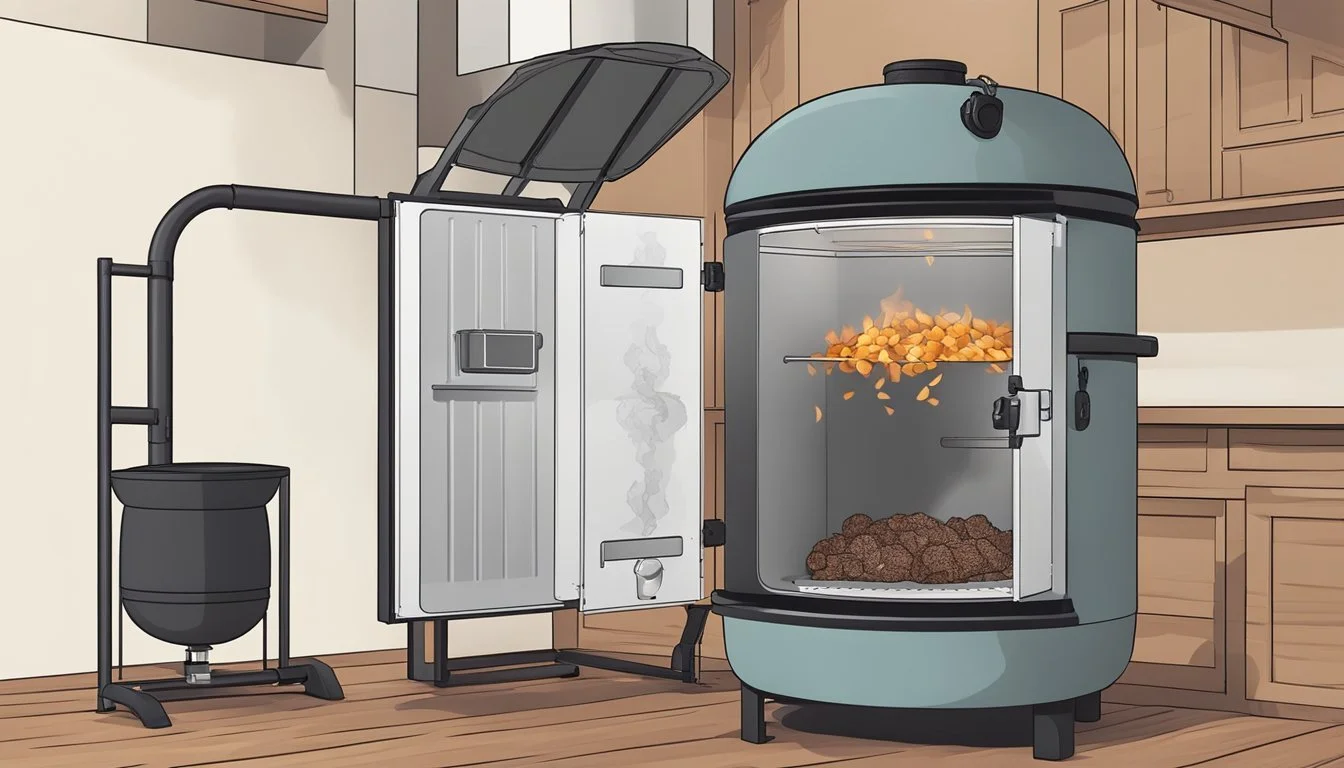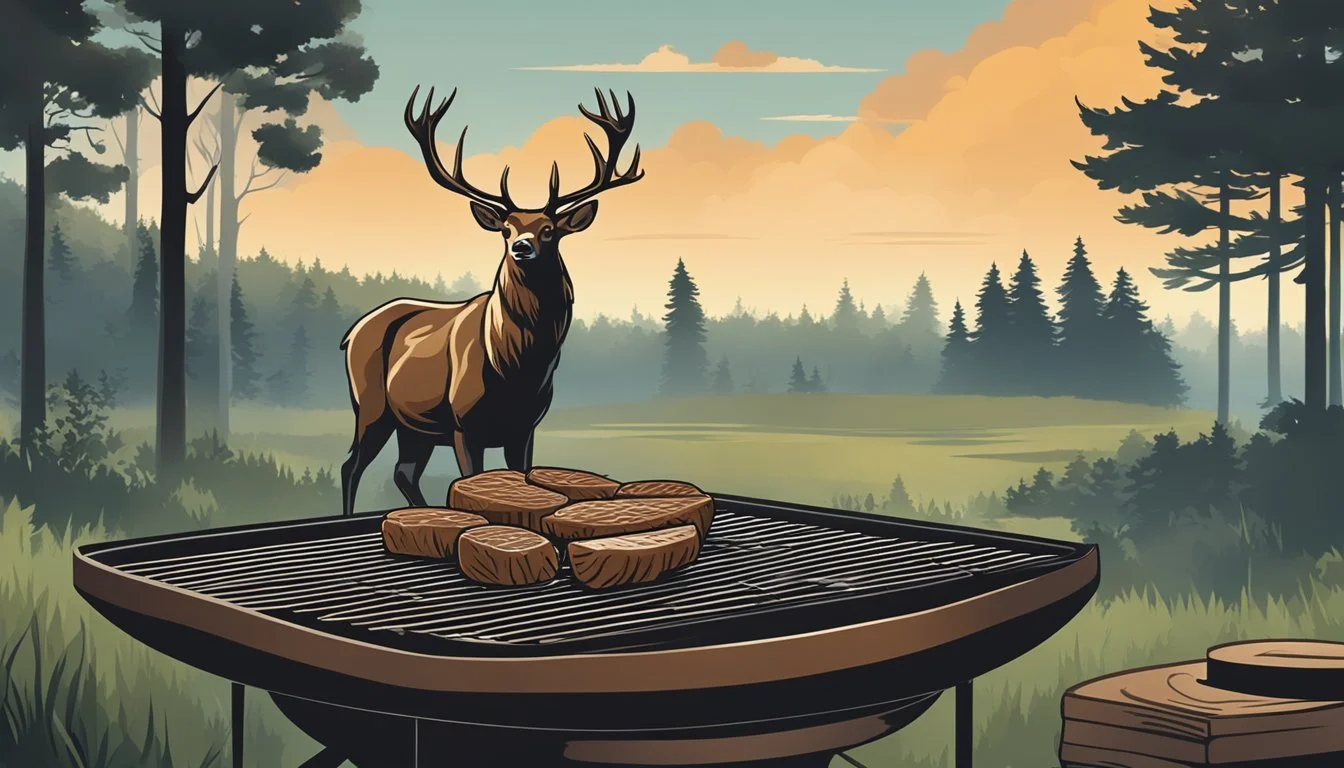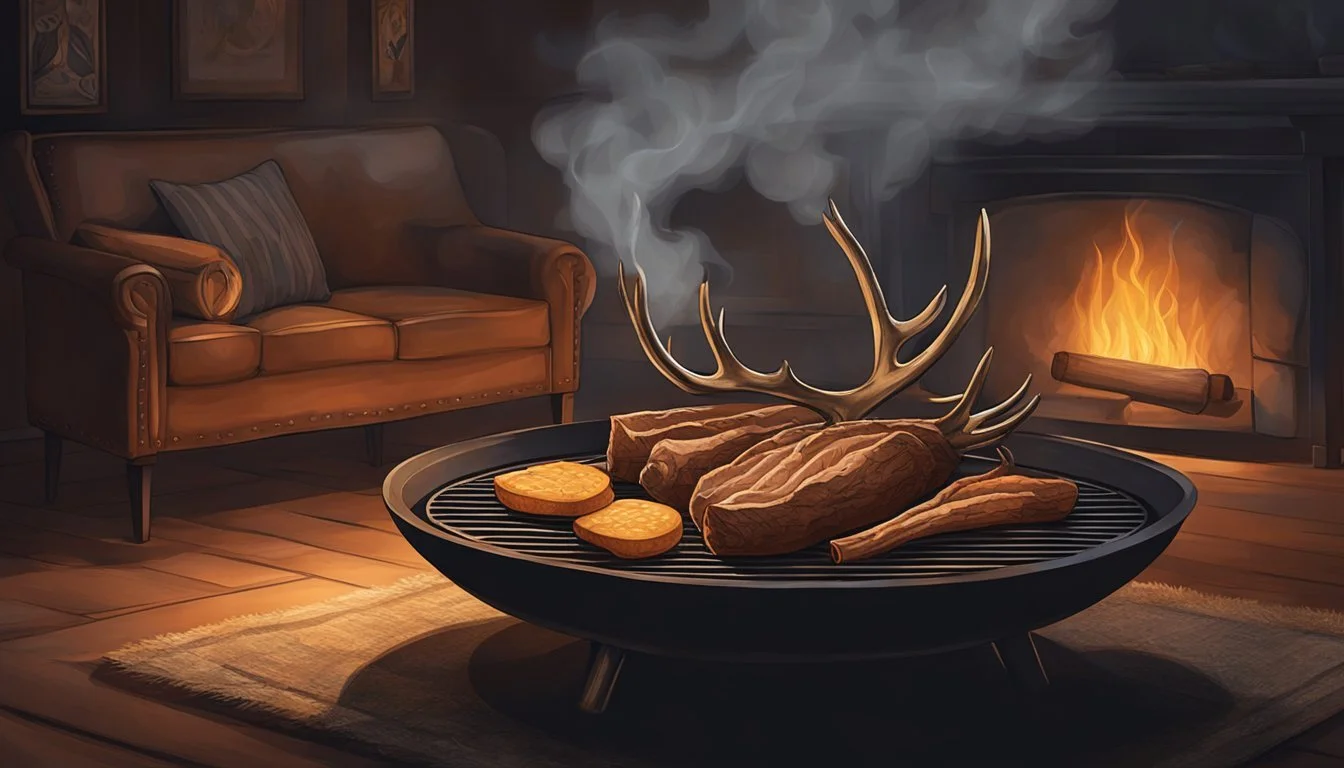The Art of Smoking Deer Meat
Masterful Tips and Techniques for Delectable Venison
Smoking deer meat is an esteemed culinary technique that transforms the robust, natural flavor of venison (What wine goes well with venison?) into a rich and smoky delicacy. When done correctly, the smoking process gently cooks the meat, allowing the smoke from carefully selected wood chips to permeate and tenderize the venison, enhancing its taste without overpowering its inherent gamey notes. The key to achieving a delicious flavor lies in the slow cooking method and the ability to maintain a consistent smoker temperature throughout the cooking time. Hunters and cooks alike know the importance of this patience-rewarding process.
Choosing the right type of wood chips is a vital step as it contributes significantly to the flavor of the venison. Popular choices such as hickory, oak, or applewood offer different nuances to the meat's taste, with each type of wood imparting a distinct smoky flavor. Preparing the meat also plays a crucial role; trimming off the excess fat and connective tissues is essential, as venison fat can result in a less desirable flavor and texture compared to beef fat. A thorough pat-down with a paper towel ensures the meat is ready for a rub of favorite seasonings, which might include black pepper, onion powder (how long does onion powder last?), and fresh herbs (how long do fresh herbs last?), before setting it on the smoker rack.
Achieving the perfect internal temperature is critical to ensure the venison is safely cooked while preserving its moisture and tender muscle fibers. A general guideline of one hour per pound of meat is often suggested, but precision is always favored for the best outcome. As the smoking process unfolds, a watchful eye on the temperature ensures the venison roast remains succulent. Following a period of slow cooking, it is beneficial to let the meat rest, allowing the flavors to further infuse and settle throughout the venison, ensuring the finished product is a flavorful meat that stands as a testament to the seasoned hunter’s culinary adventure.
Choosing the Right Type of Wood for Smoking
Selecting the proper wood for smoking venison is a critical step in the cooking process, as it infuses the meat with desirable smoky flavors (What wine goes well with smoky flavors?) and complements its natural taste. The wood's influence on the final product ranges from subtle undertones to rich, bold smokiness, which can either enhance or overpower the venison's flavor.
The Most Popular Wood Choices for Venison
Hickory: Known for its strong, smoky flavor that can tame the venison's gamey taste.
Oak: Provides a mild, versatile smokiness and is a safe choice for those new to smoking venison.
Mesquite: Offers a rich flavor but should be used sparingly due to its intensity.
Apple: Delivers a sweet, fruity smoke which is typically too mild on its own but ideal when mixed with stronger woods like oak.
Achieving the Best Smoky Flavor
Internal Temperature: Target an internal temperature ideal for venison, usually around 130°F to 140°F for medium-rare.
Wood Chips vs. Chunks: Depending on your smoker, choose wood chips for quicker smoke release or chunks for a longer, sustained smoke.
Combining Woods: Mix woods like apple and oak to balance the smoke intensity and add complexity to the flavor.
Smoker Temperature: Maintain a consistent smoker temperature, often around 225°F to 250°F, for optimal smoke penetration and even cooking.
Smoking Process: Expect to smoke venison for about 1 hour per pound, but always verify by meat's internal temperature.
Preparing the Deer Meat Before Cooking
Before smoking deer meat to achieve that perfect blend of smoky and flavorful venison, proper preparation is critical. This involves removing unnecessary fat, aging the meat, and seasoning it to enhance its natural flavors.
Trimming Excess Fat and Silverskin
Properly trimming the deer meat is key to ensuring a delicious finished product. Begin by removing the excess fat and silver skin with a sharp knife. This will allow the smoke to better penetrate the meat and enhance its flavor. Leaving too much fat can result in a greasy texture, while silver skin can become tough during the smoking process.
Example of Trimming Process:
Lay the meat on a clean surface.
Use a sharp knife to carefully slice away fat.
Peel off the silver skin without removing too much of the muscle fibers.
Dry Aging vs Wet Aging the Venison
Aging the meat is about tenderizing the muscle fibers and concentrating the flavor. Dry aging involves hanging the meat in a controlled environment for a specific period of time, usually several days to several weeks. This process enhances the flavor and tenderness of the meat by allowing enzymes naturally present in the meat to break down the muscle fibers. On the other hand, wet aging entails sealing the meat in a vacuum-packed bag, which retains moisture and also tenderizes the meat. Both methods should be done under strict temperature-controlled conditions to prevent spoilage.
Aging Methods:
Dry Aging: Let the meat hang uncovered in a refrigerator with consistent humidity and temperature for up to several weeks.
Wet Aging: Vacuum seal the venison and let it sit in the cooler for a similar time frame.
Seasoning the Meat for Maximum Flavor
Seasoning venison before smoking is essential for locking in flavor and complementing the natural taste of the meat. Create a dry rub using salt and black pepper as a base, and consider adding richly flavored spices like cayenne pepper for extra flavor. Fresh herbs and a touch of olive oil can also be used to marinate roasts and steaks. Before applying your seasoning, pat the meat dry with a paper towel.
Basic Seasoning Blend:
2 tsp of salt
1 tsp of black pepper
1/2 tsp of onion powder
1/2 tsp of cayenne pepper (optional)
Fresh herbs (quantity varies by preference)
For maximum flavor, cover the meat in the selected seasoning and let it rest, allowing the spices to penetrate the meat, for at least an hour per pound. This will also help reduce the gamey flavor sometimes associated with venison and replace it with a rich, delectable taste profile.
Using an Electric Smoker for Deer Meat
When smoking venison in an electric smoker, precision in temperature, meat placement, and consistent heat are crucial to ensuring the venison's flavor and tenderness are enhanced without losing its natural characteristics.
Setting the Ideal Temperature for Venison
Preheat your electric smoker to approximately 225°F for most cuts of venison. This temperature facilitates slow cooking that is vital for breaking down the connective tissues without overcooking, preserving the venison's delicious flavor. Lean cuts, like a venison steak, reach the desired doneness with an internal temperature of about 130°F, which is typically medium-rare.
Arranging the Meat Properly on the Smoker Racks
Place the venison roast on the smoker rack, ensuring it's patted dry with a paper towel to aid in better smoke adherence. If accompanied by roasted vegetables, (What wine goes well with roasted vegetables?) coat them lightly in olive oil and season. Vegetables can be placed around the meat if space allows. Even spacing ensures heat and smoke circulate freely, cooking the venison evenly and infusing the smoky flavor throughout the meat.
Maintaining Consistent Heat for Even Cooking
An electric smoker is adept at maintaining a steady heat. Monitor the smoker temperature during the smoking process to prevent any drastic fluctuations that could affect the cooking time. Wood chips should be chosen based on the desired flavor profile; for instance, hickory or apple wood chips impart a rich flavor, countering the natural gamey flavor of the meat. Use a smoker box for the chips and refill as needed, usually once an hour, to maintain a consistent smoky quality in the final product.
Smoking Deer Meat on a Grill
Smoking deer meat on a grill is a game-changer for those seeking to enhance venison's already rich flavor while taming its gamey profile. This section unveils techniques to maximize smoky taste, maintain proper heat levels, and achieve perfect doneness.
Maximizing Smoky Flavor on a Grill
For that quintessential smoky undertone, using wood chips specifically chosen to complement venison is essential. Some popular choices are hickory, oak, and applewood. Before grilling, soak wood chips for roughly 30 minutes, then place them directly on the heat source or in a smoker box. The resulting smoke intricately weaves a delicious flavor into the meat, elevating its natural taste.
Regulating the Grill's Temperature
Control of the grill's temperature is crucial to the cooking process, keeping in mind that venison thrives in low and slow environments due to its lean nature. Aiming for an internal temperature of 130°F for steaks and up to 160°F for tougher cuts like roasts ensures tenderness. Usage of an electric smoker can assist with this as it allows for precise temperature adjustments, smoking venison for an hour per pound ideal for optimal texture and moisture.
Flipping and Basting for Perfect Results
Regularly flipping venison on the grill promotes even cooking, giving hunters the perfect exterior without overcooking the delicate muscle fibers within. Basting with a mixture of olive oil, fresh herbs, black pepper, and onion powder can boost moisture and create a barrier that locks in flavors. After reaching the desired internal temperature, allowing the meat to rest on a plate away from heat lets the juices redistribute, concluding the preparation with succulence and ready to satisfy the palate.
Cook Times and Internal Temperatures
The precision in cooking times and reaching the correct internal temperatures is crucial for smoking deer meat to enhance its flavor and ensure food safety.
Factors that Affect Total Cook Time
Several elements play a role in determining the cook time for deer meat. The thickness and cut of the meat, the consistent maintenance of the smoker temperature, and the type of smoker used (electric or traditional) all influence the time it takes to thoroughly smoke the venison. Generally, for smoking deer meat, a guideline of approximately 1 ½ hours per pound is suggested.
Recommended Internal Temps for Safety
To ensure venison is safe to consume, it's imperative that the meat reaches the appropriate internal temperatures. For most venison cuts, like roasts or steaks, the recommended internal temperature range is between 130°F (for medium-rare) and 165°F (for well-done). Using a reliable meat thermometer will aid in accurately determining these temperatures.
Venison Steaks & Roasts: 130°F to 165°F
Ground Venison: At least 160°F
Venison Sausages: 160°F to 165°F
Letting the Meat Rest Before Serving
After smoking, it's important to let the meat rest for a period of time before serving. This allows the muscle fibers to relax and the juices to redistribute throughout the meat, enhancing the overall flavor and tenderness. A rest period of 10-15 minutes on a warm plate covered loosely with foil is typically recommended for cuts like venison steak. For larger roasts, a longer rest time may be beneficial.
Incorporating Additional Flavor
Enhancing the flavor of smoked venison goes beyond the basics of cooking; it involves a mixture of seasoning, fats, and other ingredients that complement the natural taste of the meat and elevate the overall sensory experience.
Using Herbs, Spices and Rub Seasonings
A critical step in preparing venison is selecting the right combination of seasonings to enhance its rich flavor without overpowering it. Season the meat generously with a blend of salt, black pepper, and additional spices such as onion powder or cayenne pepper which adhere to the meat's surface, creating a crust that seals in natural juices. Adding fresh herbs like rosemary or thyme can also impart a subtle, earthy undertone to the meat.
Rub Ingredients:
Salt
Black pepper
Onion powder
Cayenne pepper
Fresh herbs (e.g., rosemary, thyme)
Adding Smoked Fats or Aromatic Oils
To introduce an extra layer of flavor and to help keep the venison moist, one can baste the meat with fats or oils. Brushing on beef fat or olive oil during the smoking process allows the meat to retain moisture. The application should occur a few times throughout slow cooking, especially when the meat's surface appears dry. This can aid in breaking down connective tissues, enhancing the tenderness of the venison.
Basting Options:
Beef fat
Olive oil
Cooking Venison with Other Ingredients
The venison's flavor can be enriched by smoking it alongside other ingredients that release their flavors into the meat. For example, roasted vegetables on the smoker rack or in a cast iron skillet beneath the venison can absorb and share their flavors through the cooking atmosphere. The vegetables' caramelization can contribute a sweetness that balances the meat's gamey notes.
Complementary Ingredients:
Roasted vegetables
Aromatic vegetables (e.g., garlic, onions) (What wine goes well with onions?)
In preparing smoked venison, it is imperative to consider the internal temperature, aiming for at least 160°F to ensure safety, and the choice of wood chips, such as hickory or apple, which infuse the meat with a distinct smoky flavor. Remember, the process is not rushed; typically, it requires an hour per pound of meat, making it an exercise in patience and precision for a deliciously flavored final product.
Delicious Smoked Venison Recipes
For hunters and culinary adventurers alike, smoking deer meat unlocks a rich flavor not achievable by other cooking methods. Hearty smoked venison roast, succulent deer meat steaks, and flavorful homemade jerky are among the tantalizing recipes afforded by the slow cooking process. Each recipe highlights the natural flavor of venison while tempering any gamey undertones.
Smoked Venison Roast with Vegetables
Ingredients:
1 venison roast (3-4 pounds)
Olive oil
Favorite seasoning blend
Instructions:
Preparation:
Pat the venison roast dry with a paper towel. Rub olive oil and your favorite seasoning onto the meat.
Coat vegetables lightly with olive oil and sprinkle with salt, pepper, and fresh herbs.
Smoking Process:
Preheat the smoker to 250°F and place the roast on the smoker rack.
Surround with seasoned vegetables.
Cooking Time:
Smoke the meat for about an hour per pound, aiming for an internal temperature of 145°F for medium rare.
Let the roast and vegetables smoke until the vegetables are tender and the venison reaches the desired doneness.
Wood Chips:
Use hickory or oak for a robust smoky flavor.
Finished Product:
The venison roast will have a delicious smoky exterior while preserving the natural succulence, complemented by the roasted vegetables.
Smoked Deer Meat Steaks
Ingredients:
Venison steaks
Salt and black pepper
Onion powder
Cayenne pepper (optional)
Instructions:
Seasoning:
Season steaks generously with salt, black pepper, onion powder, and a touch of cayenne pepper for extra heat.
Smoking Process:
Set your electric smoker to 225°F.
Smoke steaks for approximately 20 minutes for rare (adjust time for preferred doneness), aiming for an internal temperature of 130°F.
Finish on a Hot Skillet:
Heat a cast iron skillet over high heat and briefly sear each side of the steak for a flavorful crust.
Choice of Wood Chips:
Apple or cherry wood chips offer a sweet contrast to the rich venison flavor.
Finished Product:
The steaks will exhibit a smoky undertone that complements the meat's flavor, with a crusty exterior from the hot skillet finish.
Making Your Own Venison Jerky
Ingredients:
2 pounds of venison meat, sliced thin
Your choice of marinade or dry rub
Instructions:
Preparation:
Marinade thin slices of venison in your choice of wet or apply a dry rub of spices. Let it rest in the refrigerator for a period of time to absorb flavors.
Dehydrating Process:
Place marinated venison strips onto the smoker rack without overlapping.
Set the smoker between 160°F to 180°F.
Period of Time:
Smoke for around 4 to 6 hours, checking periodically, until the jerky is dry but still pliable.
Wood Chips:
Mesquite chips are a popular choice for they impart a bold flavor to the jerky.
Finished Product:
Expect a delectably chewy, flavorful meat that's perfect for snacking or on-the-go nourishment.








